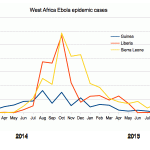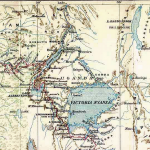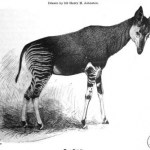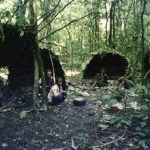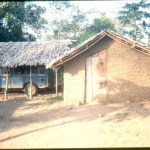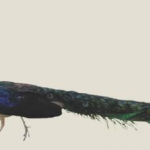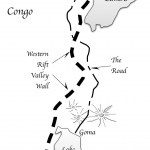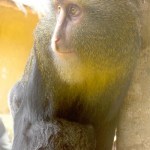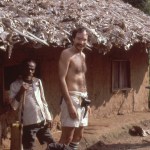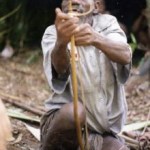Congo
The Lese people practice swidden horticulture in the Ituri Forest, Congo (formerly Zaire). Living in the same area are the Efe people, sometimes known as Pygmies (but that may be an inappropriate term). The Efe and Lese share a culture, in a sense, but are distinct entities within that culture, as distinct as any people living integrated by side by side ever are. The Efe are hunter-gatherers, but the gathering of wild food part of that is largely supplanted by a traditional system of tacit exchange between Efe women and Lese farmers, whereby the Efe provide labor and the farmers provide…
I just watched, at a the Twin Cities Science Film Festival, a film called Nzara '76, which is about the first known Ebola outbreak, the one that gave it its name, in southern Sudan. That's about 150 miles, as the Mvo-Mvo flies, north of my long term project area in the Ituri Forest, an impassable distance over an unforgiving terrain if you are a person, well within the migratory range of an Ebola carrying fruit bat.
Back in the day, when Ebola would strike here and there, killing dozens, then disappearing back into the wild as quickly as it came, there was not much movement to get a…
A recent twitter conversation prompted me to dig up some old posts on cannibalism, and maybe a few memories of my time in Central Africa.
The twitter conversation concerned a story in which it is claimed that James Jameson, heir to the Jameson Irish whiskey empire, bought a slave girl (for the price of six handkerchiefs) in order to watch her be eviscerated and eaten by cannibals, and in particular, so that he could make some nice watercolor painting of the event. Apparently this is going around the internet.
If this is true, which as I will argue in a moment is not actually the case, then…
Jim Moore and I were both students in the PhD Program in Anthropology at Harvard a few years ago. He graduated about the time I entered the program. To give a rough historical touchstone, I remember the day he needed to get his thesis off to the Registrar, and there was a delay because it was taking longer than expected to deburst the pages fresh out of the printer. Anyway, Jim is Professor of Anthropology at UC San Diego, and has done a great deal of work with Old World Primates, the evolution of social systems, and related topics. A while back Jim wrote an important piece for American…
...
As instructed, I arrived at the New Stanley Hotel, in downtown Nairobi, at just before 11:00 AM, to meet Pat Soffer, primatologist. Willoughby didn't have to tell me about the fish and chips at the hotel's cafe; I'd eaten here many times. The Thorn Tree was a pretty standard meeting place in Nairobi. A block or so from the Hilton, at the end of the main downtown street, a short walk from the central government buildings, across from a central bus station, it was a slightly pricey but reasonable hotel with an inexpensive, leisurely outdoor restaurant open early in the morning for…
“First, we’re going to collect our data,” Jack, the archaeologist, was telling me as we slogged down the narrow overgrown path. He seemed annoyed. “Then, we’ll leave. Until we leave, they won’t leave. They think it would be rude. After they leave, we’ll go back and map in the abandoned camp.”
I had just arrived at the research camp in the Ituri Forest, then Zaire and now the Congo, after a rather long and harrowing journey that took me from Boston to New York to London to Lagos to Kinshasa to Kisingani to Isiro, all by plane, then over 250 kilometers of increasingly less road-like road, to…
At the beginning of the 20th century, a traveler in Central Africa made mention of some strange people that he had come across. He was traveling among regular, run-of-the-mill natives…probably Bantu-speaking people living in scattered villages and farming for their food. But along the way, strange people came out of the forest. These strange people had sloping foreheads; they were short of stature, bow-legged and otherwise misshapen. They also clearly were, in the eyes of the traveler, of subhuman intelligence. The traveler described these people as a separate, subhuman race that lived in the…
I first became aware of, and read, King Leopold's Soliloquy, which is not his soliloquy but a parody of what he might say according to Samuel Clemens, while doing fieldwork in the ex-Belgian Congo. That is where the real story that inspired the essay took place. I lived in an area that at one time had a few a plantations, but the plantations only existed briefly and are now long gone. The "road" through this area was passable only with a very tenacious four wheel drive vehicle (we had a Land Rover) and grew worse every year. But the road at one time was excellent.
I knew a guy, an older…
We were discussing insects. What about eating insects?
When it comes up that I've lived in the Central African Rain Forest, certain questions often come up, and one of them is: "Did you eat bugs?"
Every one has seen those National Geographic specials where some natives somewhere are eating insects, and of course, Westerners who think they generally don't eat insects are fascinated with the idea. However, Westerners eat a lot more insects than they think. You should really consider any processed food you eat that started out as a plant crop to be part insect. If what you are eating is…
A friend of mine told me this story: As a special forces soldier, a Green Beret, he was alone and traveling through a dense area of jungle in or near Viet Nam during the 1960s. Enemy soldiers were nearby and he intended to pass through their patrol area to arrive at some safe destination, but he fully expected to run into a trip wire, a sentry, or a squadron of hostiles. His rifle was loaded and ready to fire at any moment.
Suddenly, a figure loomed in front of him. Without waiting for even a fraction of a second, he fired on it with lethal effect. The figure fell to the floor of the jungle…
Sungudogo, the highly entertaining and exciting adventure novella set in the Central African rain forest, which provides the Skeptics Movement with its own Origin Myth, has been available on the Kindle for a while now, but it is now also available on Smashwords, HERE.
...
Sungudogo is a little known zoological mystery, an “undiscovered” primate living in the remote and rugged region of the eastern Congo, where the Central African Rain Forest fringes the high walls of the western edge of the Great Rift Valley.
Sometimes called the “fourth African ape,” Sungudogo is not a Gorilla, not a…
Check it out:
Thank you Sarah!
Here's the Sungudogo Page in case you want to experience the pain of reading it too! (I mean the good kind of pain, of course.)
...Sungudogo is a little known zoological mystery, an “undiscovered” primate living in the remote and rugged region of the eastern Congo, where the Central African Rain Forest fringes the high walls of the western edge of the Great Rift Valley.
Sometimes called the “fourth African ape,” Sungudogo is not a Gorilla, not a Chimpanzee, not a Bonobo, and possibly not even real.
Years ago, Sungudogo drew the interest of the world famous primatologist Dieter Phillips, who was funded by a secret society of “scholars and gentlemen” to launch an expedition to determine the veracity of this mysterious…
Adult male lesula monkey discovered in the Democratic Republic of Congo. Image: M. Emetshu. PLOS One, doi:10.1371/journal.pone.0044271.g007.
Dr. John Hart, Scientific Director of the Lukuru Wildlife Research Foundation in Kinshasa, discovered the colorful lesula monkey while sifting through photos brought back from a 2007 field expedition to the Democratic Republic of Congo. Shown in the photo was a little girl named Georgette feeding one. The monkeys have blond manes and upper chests with a bright red patch on their lower backs. After extensive…
Left: Efe (Pygmy) man. Right: White guy.
Some of the people who live in the rain forest of Central Africa are known widely as "Pgymies." That word...Pygmy...is considered problematic for a few different reasons. It refers to a person's physical appearance, because it means "small." The word is sometimes used in biology to refer to the smaller species among a group of closely related species, as in "Pygmy Hippopotamus" or "Pygmy Chimp." In English and probably some other languages, the term is used in a derogatory way to refer to someone who is perceived as not very smart, as in "Pygmy…
A compendium of selected posts written about the Ituri Forest, the Efe Pygmies, and other folks and other things in the region:
In the matter of insects:
No Place to Sit Down
The reason the Efe won't normally kill an insect ...
"Excuse me, there's some food in my bugs!"
Day of the locust. Yum!
"We Live In Little Houses Made of Beans"
The curious world of bugs
Life in the forest
How to kill a monkey
How to carry your monkey home once you've killed it
A story of my friend Kobou
Camp life
Cultural Wanderings
A look at some traditional medicine, cross culturally
Total eclipse of the sun and…
Acupuncture is the ancient East Asian practice of poking people with needles in specific places and in specific ways in order to produce any one of a very wide range of results that could generally be classified as medicinal or health related. I don't know much about it, but Wikipedia tells us:
Its general theory is based on the premise that bodily functions are regulated by the flow of an energy-like entity called qi. Acupuncture aims to correct imbalances in the flow of qi by stimulation of anatomical locations on or under the skin called acupuncture points, most of which are connected by…
Wildlife of Southern Africa , by Martin Withers and David Hosking, is new (August 2011) and good. If you are planning a trip to South Africa, Namibia, Botswana or anywhere nearby, or if you live there and like to go to the bush sometimes, consider it.
This is a pocket guide, it is small, has good photographs, is inexpensive, and accurate.
In my opinion, if you are travelling around Africa looking at wildlife, you will need a set of more specialized guides (which I've discussed at length elsewhere on this blog, see below), but this is a good extra to carry along or to have handy, depending…
I remember my first solar eclipse. I was a kid, and it was the one Carlie Simon sang about, in March 1970.
(The eclipse reference is just past three minutes. Some other time we can argue over whether or not Carlie, singing in this video on Martha's Vineyard, was referring to the March 1970 eclipse or the July 1972 eclipse, but I'm sure it was the former, because that's the one everybody got all excited about.)
I was such a geek that I actually missed the eclipse because I was busy collecting data. There was a phone number you could call and a lady's voice would give you the time and…
As an archaeologist, my expertise in the cognate field of geology includes fluvial processes, so I know something about floods. And I've experienced plenty of floods working in the Hudson and Mohawk river valleys ... now that I think of it, I've got quite a few good flood stories. But the most significant experience I've had with flooding happened in about a foot of water.
It was in the Congo, at Senga, a location I've written about before. Our camp was on one side of a wash right where it entered the Semliki River, and the excavation was on the other side of the wash, but since the…
